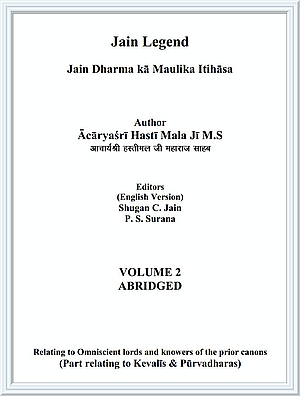After Yaśobhadra Swāmī, Śrī Saṃbhūtavijaya and Bhadrabāhu Swāmī became the sixth Pontiffs of Lord Mahāvīra.
Not much information is available about Ācārya Saṃbhūtavijaya. Only this much is known that he was a Brahmin of Maḍhara Gotra. In Pontifical chronology of Tapagacha about his name it is written like this: "Padhasamūdayopacharatha Saṃbhūthethi Śrī Saṃbhūtavijaya Bhadhathi." Ācārya Śrī Saṃbhūtavijaya was born in 66 V.N. He led a family life up to the age of 42. He was impressed by the sermons of Ācārya Yaśobhadra and was initiated into the ascetic life of a Śramaṇa in V.N.108. Leading a faultless and virtuous life of a Śramaṇa, he thoroughly studied 'Dwādaśāṃgī' under the able guidance of Ācārya Yaśobhadra and acquired the position of a Śrutakevalī. He served the congregation as a normal monk for 40 years and was elevated to the rank of a ācārya in 148 V.N. He led the organisation in an efficient manner up to V.N.156. He was well versed in the 14 Pūrvas and rich in divine powers of speech, and hence could convert numerous people immersed in worldly pleasures, into the path of sacrifice and asceticism. Sensuous layman Ārya Sthūlabhadra was also his disciple, who is reckoned as the first and foremost among great yogis. According to chronology of elders (Sthavirāvalī), the names of his male and female Sthavira disciples are as follows:
Male Disciples:
- Nandanbhadra
- Upanandanabhadra
- Tīsabhadra
- Jasabhadra
- Sumanabhadra
- Maṇibhadra
- Pūrṇabhadra
- Sthūlabhadra
- Ujjumaī
- Jambū
- DīrghaBhadra and
- Paṇdubhadra
Female Disciples:
- Jakkhā
- Jakkhadiṇṇā
- Bhūyā
- Bhūyadiṇṇā
- Seṇā
- Veṇā and
- Reṇ, all the seven were the sisters of Ācārya Sthūlabhadra.
In the year 156 V.N. he realized that he was nearing death; he underwent fast and attained Samādhi and went to heaven.
Here it is noteworthy that starting from Ārya Sudharmā, the first Successor of Lord Mahāvīra to Ācārya Yaśobhadra i.e. up to the fifth Pontiff, the tradition of being led by "one" ācārya was prevalent in the Śramaṇa congregation. Remaining ācāryas like Discourse-ācārya, etc., performed their duties under the auspices of a single successor ācārya. But Ācārya Yaśobhadra, breaking the convention declared both the Śrutakevalīs - Saṃbhūtavijaya and Bhadrabāhu as his successors. Why did he opt for two ācāryas as his successors instead of one? There is no substantial explanation for this. However it can be assumed that as the size of the congregation increased in multiples, to facilitate the smooth administration of the vast congregation, he might have opted for two ācāryas, where, one would look after the internal matters and the other would take care of external issues. Thus he had laid the foundation for the custom of two ācāryas.
It is indisputably proved that Ācārya Saṃbhūtavijaya remained as ācārya, the prime head of the organisation from 148 to 156 V.N. and only after his demise Ācārya Bhadrabāhu took the reins into his hands. In spite of two ācāryas being nominated, the congregation was run by Ācārya Saṃbhūtavijaya from 148 to 156 V.N. and by Ācārya Bhadrabāhu from 156 to 170 V.N. So it is unteneable to presume that the seed of differences was sown during that period.
Digambara tradition
According to the Digambara School, Ācārya Govardhana was considered as the fourth Śrutakevalī. However, there is no noteworthy introduction of him in any of their scriptures and texts.
 Acharya Hasti Mala
Acharya Hasti Mala
